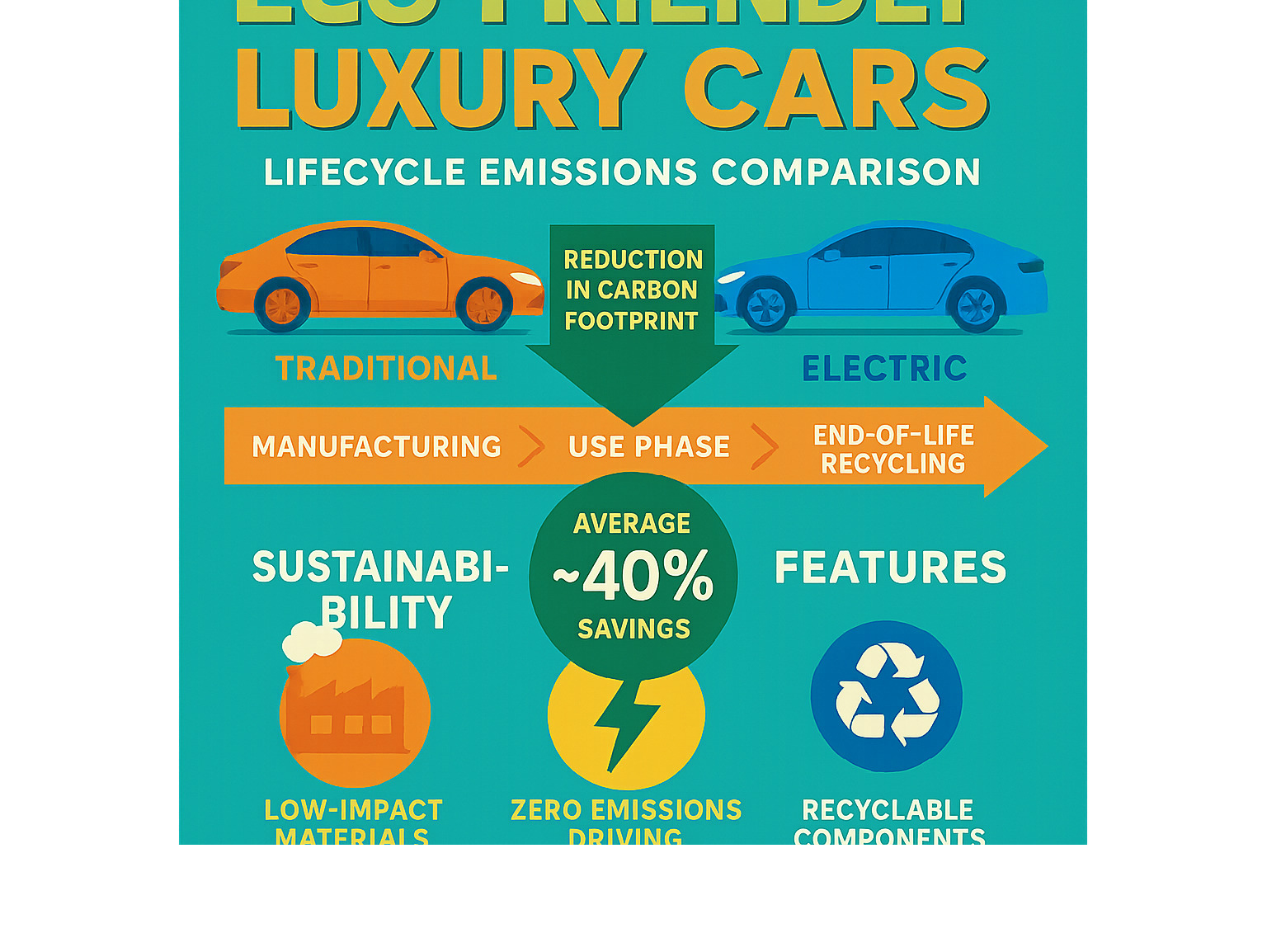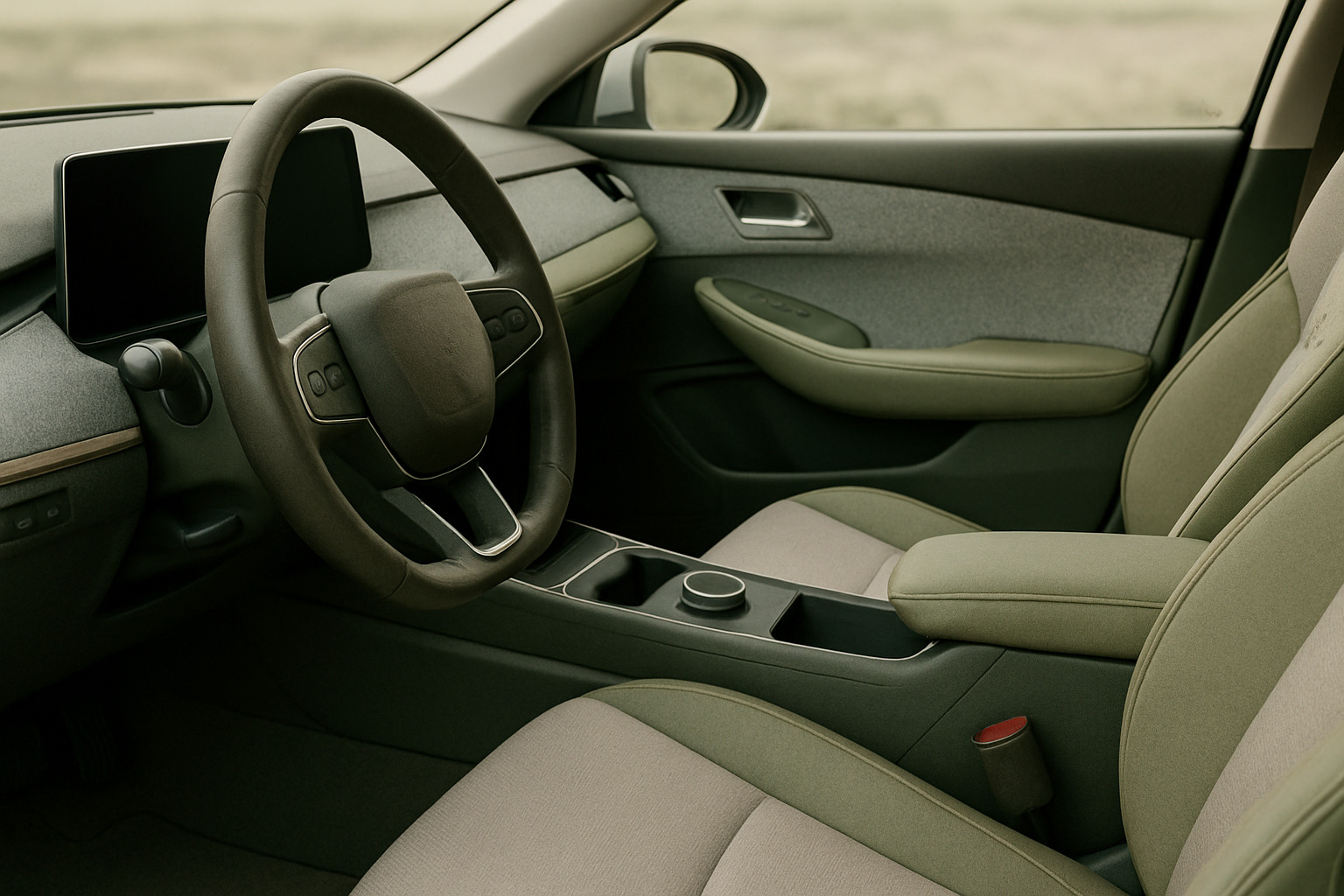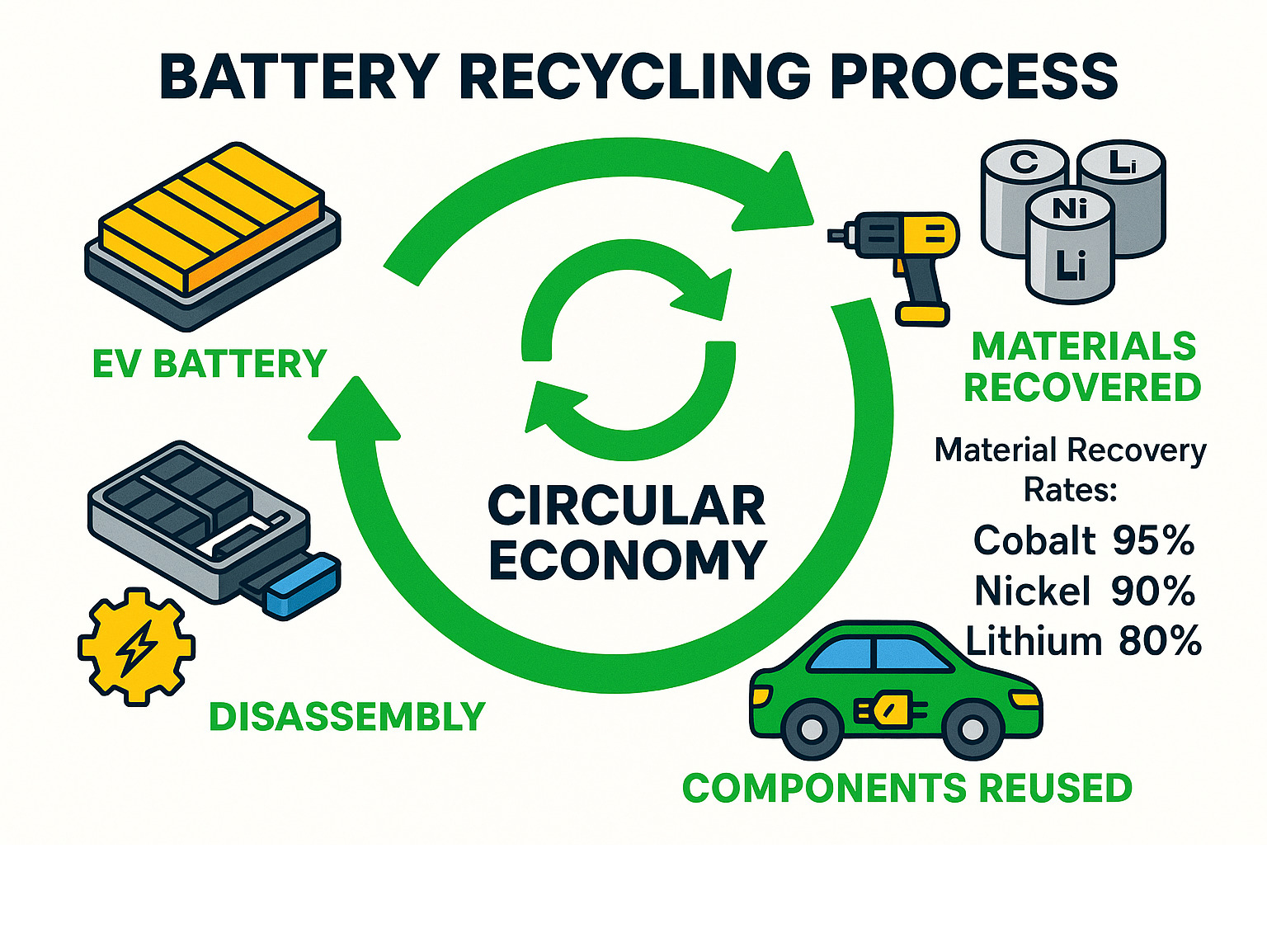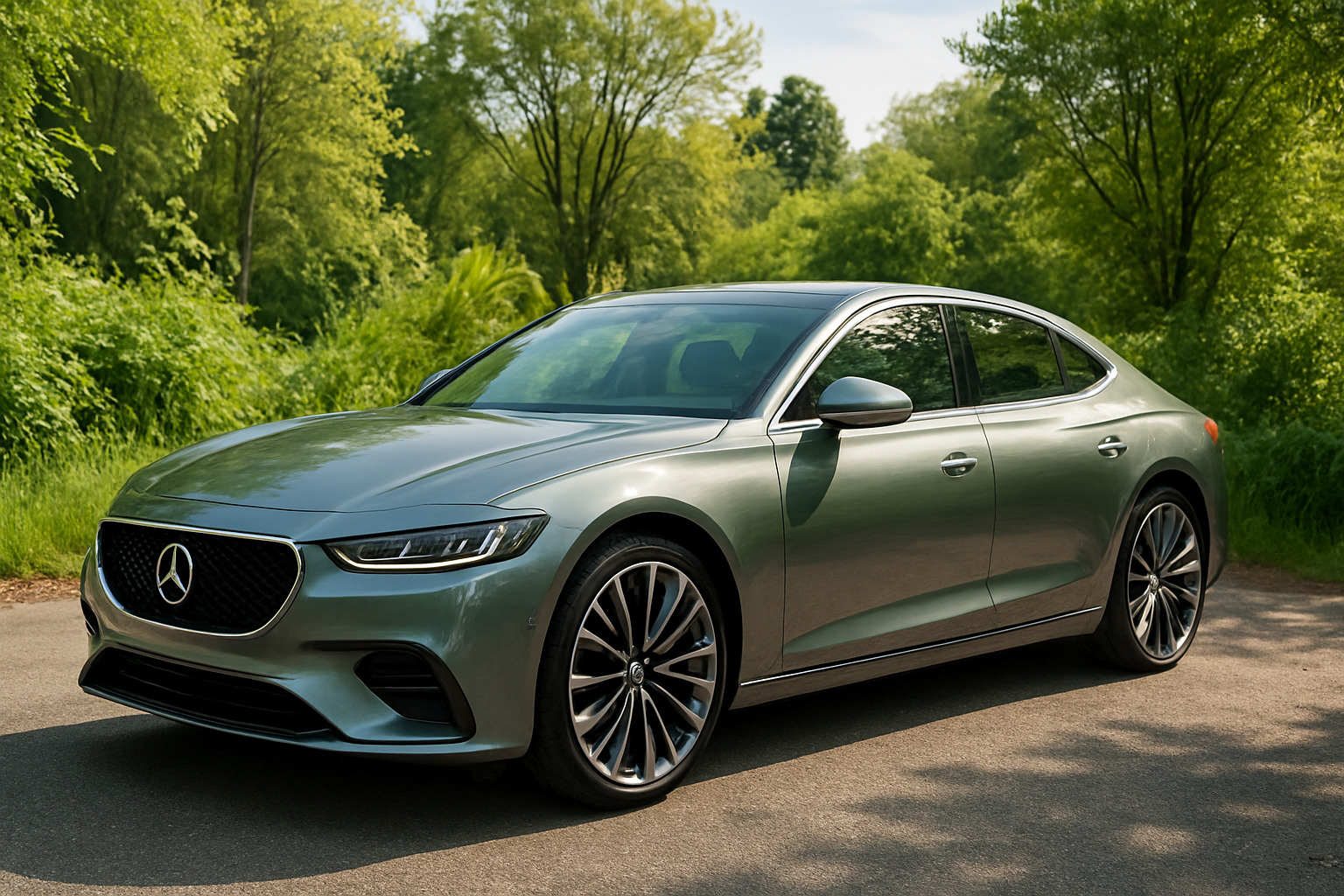Eco Friendly Luxury Cars: 10 Best Powerful Picks 2024
The Rise of Sustainable Opulence
Eco friendly luxury cars are revolutionizing the automotive landscape by combining premium features with environmental consciousness. For those seeking quick guidance on the best options in this category, here are the top eco-friendly luxury vehicles currently available:
| Model | Range | Performance | Key Sustainability Feature |
|---|---|---|---|
| Lucid Air | Up to 512 miles | 0-60 in 1.89 seconds | Bi-directional charging |
| Mercedes EQS | 352 miles | 0-60 in 5.8 seconds | “One bow” aerodynamic design |
| Porsche Taycan | 227 miles | 0-60 in 2.6 seconds | 800V architecture for faster charging |
| BMW iX | 324 miles | 0-60 in 3.8 seconds | Sustainable interior materials |
| Tesla Model S | 402 miles | 0-60 in 3.1 seconds | Industry-leading efficiency |
Being environmentally conscious is no longer just a choice—it’s becoming a necessity. The luxury automotive market has responded with remarkable innovation, creating vehicles that don’t ask drivers to choose between premium experiences and planetary responsibility.
The global shift is clear: electric car sales reached 6.6 million globally in 2021, more than tripling their market share. This surge reflects changing consumer values, with surveys showing people are prepared to pay an average of 12% more for sustainable products, including cars.
What makes this transition particularly exciting is that eco-friendly no longer means compromise. The Porsche Taycan accelerates from 0 to 60 mph in just 2.6 seconds—performance figures that rival or exceed traditional gas-powered supercars. Meanwhile, the Lucid Air offers an EPA-estimated range of up to 512 miles, eliminating the range anxiety that once plagued electric vehicles.
Luxury automakers aren’t just focusing on drivetrains. BMW aims to cut the carbon footprint of its cars by 80% per vehicle by 2030 through sustainable materials in interiors. From vegan leather alternatives to recycled ocean plastics, these vehicles represent a holistic approach to sustainability without sacrificing the comfort and craftsmanship luxury buyers expect.

Learn more about eco friendly luxury cars:
– car tech updates
– connected car technology trends
What Defines an Eco-Friendly Luxury Car?
So what exactly makes a luxury car truly “eco-friendly”? It’s far more meaningful than just swapping out a gas engine for electric motors. Today’s eco friendly luxury cars take a holistic approach to sustainability that touches every aspect of the vehicle experience.
At their core, these vehicles feature innovative drivetrains that dramatically reduce or completely eliminate tailpipe emissions. This includes battery electric vehicles (BEVs) that produce zero emissions while driving, plug-in hybrids that let you handle daily commutes on electricity alone, and even hydrogen fuel cell vehicles whose only “emission” is water vapor.
But the green credentials extend well beyond what powers the wheels. True eco friendly luxury cars incorporate sustainable materials throughout their sumptuous cabins, accept circular manufacturing processes that minimize waste, and consider the entire carbon footprint from factory floor to eventual recycling.
What’s remarkable is how these vehicles achieve their environmental goals without asking you to sacrifice an ounce of luxury. In fact, electric drivetrains often improve the premium experience – imagine gliding along in whisper-quiet comfort with instant torque that pins you to your sustainably-sourced seat covering!
| Powertrain Type | Environmental Impact | Luxury Benefits | Typical Range |
|---|---|---|---|
| Battery Electric | Zero tailpipe emissions | Silent operation, instant torque | 250-500+ miles |
| Plug-in Hybrid | Reduced emissions, electric-only city driving | Extended range, no charging anxiety | 30-50 miles electric, 400+ total |
| Hydrogen Fuel Cell | Zero emissions, water vapor only | Quick refueling, conventional range | 300-400 miles |
| Traditional Luxury | High carbon footprint, local pollution | Familiar experience, no charging needs | 350-500 miles |
Key Pillars of Eco Friendly Luxury Cars
The foundation of eco friendly luxury cars rests on several technological and philosophical pillars that make them stand apart.
Advanced Battery Technology forms the heart of any electric luxury vehicle. Today’s premium EVs use sophisticated lithium-ion batteries that maximize range while minimizing weight. Brands like Lucid have pushed boundaries with packs delivering over 500 miles on a single charge. The future looks even brighter with solid-state batteries promising greater energy density, reduced fire risk, and dramatically faster charging.
Regenerative Braking is an ingenious feature that captures energy during deceleration. Rather than wasting kinetic energy as heat through traditional brakes, these systems convert it back to electricity, extending your range while reducing brake wear. Many luxury EVs let you adjust regeneration strength to match your driving style – from a traditional coasting feel to near one-pedal driving.
Lightweight Alloys play a crucial role in efficiency without compromising safety or that substantial feel luxury buyers expect. Advanced aluminum architectures, carbon fiber components, and high-strength steel alloys create the perfect balance between performance, protection, and planet-friendly efficiency.
Ethical Sourcing has become increasingly important as manufacturers recognize their responsibility throughout the supply chain. Leading luxury brands now ensure materials like cobalt (crucial for batteries) come from responsible sources with proper labor practices and environmental standards.
Eco Friendly Luxury Cars vs. Traditional Flagships
How do these green machines compare to their gas-guzzling counterparts? The differences might surprise you.
The old “range anxiety” concern is rapidly becoming a relic of the past. Modern eco friendly luxury cars routinely offer 300+ miles of range, with standouts like the Lucid Air pushing beyond 500 miles – more than enough for a weekend getaway without hunting for a charger.
The torque curve of an electric luxury vehicle creates a distinctly different (and many would say superior) driving experience. Unlike traditional engines that need to build RPMs to deliver peak power, electric motors provide 100% of their torque instantly. This creates that addictive, effortless surge of acceleration that luxury buyers crave.
NVH (noise, vibration, harshness) refinement reaches new heights without combustion engines. The inherent quietness allows engineers to focus on eliminating road and wind noise, creating cabin environments of unprecedented serenity. Many owners report that after experiencing electric luxury, traditional engines suddenly feel crude and intrusive.
Maintenance differences are substantial too. With fewer moving parts, no oil changes, and regenerative braking reducing wear on friction brakes, eco friendly luxury cars typically require significantly less maintenance. This means fewer service visits and more time enjoying your vehicle.
Resale trends are evolving as the market matures. While early EVs suffered steep depreciation, premium electric vehicles are now showing stronger value retention as battery durability concerns fade and charging infrastructure expands. Some models are even outperforming their gas counterparts in holding value.
The shift to eco friendly luxury cars isn’t just an evolution – it’s a fundamental reimagining of what luxury mobility means in our increasingly climate-conscious world. It turns out you can have your champagne and drink it responsibly too.
The 10 Leading Eco Friendly Luxury Cars in 2024
The luxury automotive world has acceptd sustainability with open arms, changing what was once a niche segment into a thriving marketplace of innovation. Today’s eco friendly luxury cars don’t just reduce emissions—they redefine what luxury driving means in our increasingly climate-conscious world. Let’s explore the most impressive sustainable luxury vehicles of 2024, from sleek sedans to commanding SUVs.

Lucid Air Grand Touring (eco friendly luxury cars)
The Lucid Air feels like it arrived from a future where luxury and sustainability perfectly coexist. With its jaw-dropping 512-mile range, this sedan eliminates the “but what about road trips?” question that has plagued electric vehicles for years. Packing 819 horsepower into its sleek frame, the Air Grand Touring rockets from standstill to 60 mph in just 3 seconds—all without a drop of gasoline.
What I love most about the Lucid is how thoroughly it’s been reimagined for the electric age. Its bi-directional charging isn’t just a tech bullet point—it transforms your car into a power source during outages, potentially powering your home when you need it most. The spacious cabin feels like an architectural achievement, making the most of the compact electric drivetrain to create interior space that rivals much larger vehicles.
The Air’s over-the-air updates mean your car actually improves with age—a refreshing departure from the traditional depreciation curve. Inside, recycled textiles and responsibly sourced wood create a guilt-free luxury environment that feels both cutting-edge and warmly welcoming.
Mercedes-Benz EQS 450+ Sedan
Mercedes has always understood luxury, but with the EQS 450+, they’ve proven they understand the future, too. This flagship electric sedan glides through the world with a whisper-quiet presence and a range that relieves anxiety—352 miles between charges means most owners will plug in weekly, not daily.
The optional MBUX Hyperscreen transforms the entire dashboard into a sweeping 56-inch curved glass display that feels more spaceship than automobile. When you do need to charge, the EQS doesn’t keep you waiting—DC fast charging takes you from 10% to 80% in just 31 minutes, roughly the time it takes to enjoy a coffee break.
Mercedes engineers have acceptd their freedom from conventional engine packaging with the distinctive “one-bow” silhouette. This isn’t just design for design’s sake—it creates an industry-leading 0.20 drag coefficient that directly translates to extended range. The advanced heat pump system is another thoughtful touch, preserving precious range in colder climates where other EVs struggle.
Porsche Taycan Turbo S
Porsche has answered the question no one thought possible: “Can an electric car deliver the soul-stirring performance of a 911?” The Taycan Turbo S responds with a resounding yes, launching from 0-60 mph in a stomach-compressing 2.6 seconds while maintaining the handling precision Porsche fans demand.
The Taycan’s 800-volt electrical architecture represents genuine innovation, enabling faster charging and—perhaps more importantly for Porsche owners—consistent performance during spirited driving. This high-voltage system keeps heat generation in check, allowing for repeated high-performance runs without the power limitations that plague some competitors.
While the EPA rates the Taycan at 227 miles, real-world drivers consistently report exceeding this figure. More importantly, its 270 kW charging capability means brief pit stops can add significant range. Inside, Race-Tex microfiber made from recycled polyester offers the tactile pleasure of suede without the environmental concerns.
BMW iX M60 (eco friendly luxury cars)
BMW’s flagship electric SUV beautifully balances seemingly contradictory goals: sustainability, luxury, and performance. The iX M60 delivers a robust 610 horsepower from its dual-motor system, rushing to 60 mph in just 3.6 seconds while maintaining a practical 324-mile range.
What sets the iX apart is BMW’s holistic approach to sustainability. The interior features Deserttex upholstery—an innovative leather alternative crafted from cactus fibers that requires minimal water and no harmful chemicals. The floor mats incorporate ECONYL, a remarkable material created from recycled fishing nets and other ocean waste that would otherwise contribute to marine pollution.
BMW hasn’t just considered the car’s operational footprint—they’ve designed components for easy disassembly and reuse at end-of-life. Even the structural aluminum is produced using hydroelectric power, dramatically reducing the carbon impact of this traditionally energy-intensive material.
Despite its environmental credentials, the iX delivers true luxury. The cabin’s “shy tech” approach keeps displays and controls discreet until needed, creating a serene environment free from the technological clutter that can make some modern cars feel overwhelming.
Jaguar I-PACE
The Jaguar I-PACE brings British elegance to the electric revolution. Its aluminum-intensive architecture strikes the perfect balance between lightweight efficiency and structural rigidity, contributing to both its 292-mile range and the responsive handling that makes every drive enjoyable.
For the environmentally conscious luxury buyer, Jaguar offers several interior options including vegan seat materials that maintain the premium feel expected in this segment. The cabin’s exceptional quietness improves the luxury experience—without a combustion engine, Jaguar’s engineers have focused on eliminating road and wind noise to create a genuinely peaceful environment.
The I-PACE’s dual-motor all-wheel-drive system delivers 394 horsepower and a 0-60 mph time of 4.5 seconds, providing the performance expected from a Jaguar while maintaining zero tailpipe emissions. Jaguar’s commitment to improvement shows in the software updates that have improved efficiency and range since the vehicle’s introduction.
Other remarkable eco friendly luxury cars that deserve consideration include:
-
Tesla Model S Plaid: With its astonishing 1,020 horsepower and 396-mile range, it remains the benchmark for electric performance.
-
Audi e-tron GT: Sharing platform elements with the Porsche Taycan but with distinctive Audi styling and a greater focus on comfort.
-
Volvo XC60 T8 Recharge: A thoughtful plug-in hybrid offering 18 miles of electric range for daily commutes and impressive 59 mpg highway efficiency in hybrid mode.
-
Range Rover P400e: Combines traditional Range Rover luxury with a plug-in hybrid system delivering 31 miles of electric range, perfect for zero-emission trips.
-
Polestar 2: Volvo’s performance-oriented electric sub-brand delivers minimalist Scandinavian design with vegan interior options and a refreshing focus on sustainability.
For more detailed information about electric vehicles, visit our Electric Vehicles resource page.
Tech & Materials Powering Sustainable Luxury
The revolution in eco friendly luxury cars goes way beyond what’s under the hood. Today’s sustainable luxury vehicles are showcasing incredible innovations in materials and manufacturing that completely transform our understanding of premium automotive experiences.

Inside the Cabin: From Cactus to Econyl
Remember when luxury car interiors meant nothing but leather, rare woods, and materials that took a heavy toll on our planet? Those days are fading fast. The cabins of today’s eco friendly luxury cars are redefining luxury with smart, sustainable alternatives that feel just as good—or better—than traditional materials.
Take Deserttex, for example. BMW has pioneered this incredible cactus-based leather alternative in models like the iX. Made from nopal cactus, it barely needs any water to grow, requires zero pesticides, and actually absorbs CO2 while growing. When you run your hand across it, you get that same supple, premium feel without the environmental baggage of animal agriculture or harsh chemical tanning.
Then there’s Mirum, a truly remarkable innovation. This 100% recyclable material contains absolutely no plastic and is crafted from natural rubber, cork, coconut fiber, and agricultural waste. What’s really cool is how versatile it is—manufacturers can mold and texture it to mimic everything from fine-grained leather to technical fabrics. Several luxury automakers are already incorporating it into dashboards and door panels. Learn more about this material at Mirum.
Have you heard about ECONYL? It’s a fabric with a fascinating backstory—made from recycled nylon waste like discarded fishing nets, fabric scraps, and old carpet flooring. BMW, Polestar, and others are using it for carpet liners and seat fabrics. The beauty of ECONYL is that it can be recycled over and over without losing quality, creating a truly circular material.
Wine lovers will appreciate Vegea—an innovative material created from grape skins and seeds left over from wine production. It’s a brilliant example of upcycling, requiring no additional land, water, or fertilizers beyond what’s already used to make wine. The result is a sustainable alternative to vinyl and leather that’s making its way into luxury interiors.
For that soft, suede-like touch, many manufacturers are turning to Dinamica Microfiber. Made from recycled polyester and water-based polyurethane, it’s becoming the sustainable go-to for steering wheels and headliners. It gives you all the tactile satisfaction of Alcantara with a much smaller environmental footprint.
Even the wood trim in these vehicles tells a sustainability story. Rather than harvesting new timber, several luxury brands are using reclaimed wood from old buildings, fallen trees, or even underwater salvage operations. These pieces bring unique character and history to the vehicle’s interior.
What’s particularly exciting is that these materials aren’t just environmentally better—they often outperform traditional options with improved durability, easier maintenance, and reduced weight.
Exterior & Powertrain Innovations
The commitment to sustainability in eco friendly luxury cars extends well beyond what you can see and touch inside the cabin.
On the outside, aerodynamic wheels are making a significant difference. These specialized wheel designs reduce turbulence and can add meaningful range to electric vehicles. The Mercedes-Benz EQS features wheels that strike that perfect balance between looking great and cutting through the air efficiently, contributing to its remarkable 0.20 drag coefficient.
The future looks especially bright with solid-state battery development. While not yet in production vehicles, these next-generation batteries promise higher energy density, faster charging, longer lifespans, and improved safety compared to current lithium-ion technology. Several luxury manufacturers have invested heavily in developing this game-changing technology.
For the performance-minded, supercapacitors offer an intriguing alternative. Lamborghini’s Sián FKP 37 hybrid supercar uses these instead of traditional batteries for its hybrid system. They can charge and discharge much more quickly than batteries—perfect for performance applications where you need rapid energy recovery and deployment.
Some forward-thinking manufacturers are exploring solar integration, with panels built into vehicle roofs and bodies. While current technology doesn’t generate enough power to be the primary energy source, it can extend range by powering climate control systems or maintaining battery charge while parked.
Even the paint on these vehicles is getting a sustainability makeover. Water-based paints and finishes with lower VOC (volatile organic compound) emissions are becoming standard in luxury vehicle production, significantly reducing environmental impact during manufacturing.

Looking at the full lifecycle of these vehicles, battery recycling programs are becoming increasingly sophisticated. Leading manufacturers are developing comprehensive systems to recover valuable materials like cobalt, nickel, and lithium. These closed-loop approaches will be crucial as the first generation of modern EVs reaches the end of its life cycle.
The materials and technologies powering today’s eco friendly luxury cars aren’t just good for the planet—they’re creating vehicles that are more innovative, more distinctive, and often more enjoyable to own than their conventional counterparts. It’s a rare win-win where doing the right thing environmentally also creates a superior product.
For more information about automotive sustainability initiatives, visit our Automotive Sustainability Initiatives page.
Ownership Essentials: Cost, Incentives & Charging
Thinking about joining the eco friendly luxury car revolution? Beyond the sleek designs and zero-emission driving, there are practical considerations that make owning these vehicles different from traditional luxury cars. Let’s explore what your ownership journey might look like.
Real-World Costs vs. Traditional Luxury Vehicles
When you first look at the price tag of an eco friendly luxury car, you might experience a bit of sticker shock. Yes, they typically cost 10-30% more than their gas-guzzling cousins – but that’s only part of the financial story.
The savings begin the moment you stop visiting gas stations. Imagine charging your Mercedes EQS from empty to full for just $15-20, compared to dropping $80-100 filling up an S-Class with premium fuel. Those savings add up quickly, especially if you drive frequently.
Your wallet gets another break when it comes to maintenance. With no oil to change, fewer brake replacements thanks to regenerative braking, and no transmission to service, electric vehicles are maintenance lightweights. Tesla owners report spending about one-third what they used to on maintenance compared to traditional luxury cars.
Insurance is a bit of a mixed bag. Premiums tend to run higher for electric luxury vehicles due to specialized repair needs and pricier replacement parts. The good news? Some forward-thinking insurance companies now offer specific EV discounts that help offset these costs.
One unique advantage of modern eco friendly luxury cars is how they improve with age. Over-the-air software updates regularly add new features and capabilities at no extra cost – something unheard of in traditional vehicles that typically only depreciate after leaving the dealership.
Speaking of depreciation, the market has matured significantly. While early EVs lost value quickly, today’s premium electric vehicles – particularly Tesla models – hold their value impressively well.
When you calculate the total 5-year ownership costs, many eco friendly luxury cars achieve cost parity with or even beat their combustion counterparts, especially if you drive more than average.
Incentives & Regulations Steering Demand
Governments worldwide are rolling out the red carpet for electric vehicle adoption, making now an excellent time to make the switch.
In the US, federal tax credits of up to $7,500 are available for many electric vehicles under the Inflation Reduction Act (though income caps and vehicle price limits apply). This effectively slashes that initial price premium for qualifying buyers.
Don’t stop at federal incentives – dig into what your state offers too. California residents can claim up to $2,000 through the Clean Vehicle Rebate Project, while other states have similar programs that can save you thousands more.
The regulatory landscape is shifting rapidly in favor of electric vehicles. Several states and countries have announced plans to ban sales of new gas-powered cars within the next 10-15 years. Cities like London, Paris, and Amsterdam are already restricting combustion vehicles in city centers, giving electric vehicle owners exclusive access that gas car drivers don’t enjoy.
Even corporations are joining the movement, adopting sustainability targets that include electric executive transportation. These combined push-and-pull factors are creating a perfect storm accelerating the transition to eco friendly luxury cars.
Range, Charging Time & Infrastructure
“But what about range anxiety?” I hear you ask. The good news is that most modern luxury EVs deliver 250-400 miles of range under typical conditions – more than enough for daily driving with plenty to spare. The Lucid Air takes this even further with an impressive 512-mile EPA rating.
When you do need to recharge on longer journeys, today’s fast-charging capabilities make pit stops briefer than ever. The Porsche Taycan’s advanced 800-volt architecture enables charging at up to 270 kW, adding approximately 60 miles of range in just 5 minutes under ideal conditions. Most premium EVs can go from 10% to 80% charge in 20-40 minutes at compatible fast-charging stations – just enough time to grab a coffee and stretch your legs.

For day-to-day convenience, most owners find that home charging becomes their new normal. A Level 2 (240V) charger installed in your garage can fully replenish your battery overnight, meaning you start each day with a “full tank.” Installation typically costs between $500-2,000 depending on your home’s electrical setup – a one-time investment that pays dividends in convenience.
Public charging networks continue to expand rapidly. Tesla’s Boostr network remains the gold standard with over 30,000 chargers worldwide, while networks like Electrify America, EVgo, and ChargePoint are working hard to catch up in both coverage and reliability.
Perhaps most exciting are the newer models like the Lucid Air that offer bidirectional charging capabilities. These vehicles can actually power your home during outages or sell electricity back to the grid during peak demand periods – a feature that no gas-powered car can match, turning your vehicle into an energy asset rather than just a means of transportation.
For more insights into the evolving landscape of premium electric vehicles, visit our Luxury Electric Vehicle Market resource page.
Frequently Asked Questions about Eco Friendly Luxury Cars
How do electric and hybrid luxury cars differ in environmental impact?
When it comes to environmental impact, not all eco friendly luxury cars are created equal. Battery electric vehicles (BEVs) produce zero tailpipe emissions as you drive, making them the cleaner choice for your daily commute. The catch? Manufacturing those large battery packs creates a bigger carbon footprint upfront than building traditional engines.
Think of it as an environmental investment that pays dividends over time. Your electric luxury car might start with a higher carbon “debt,” but it typically breaks even after 20,000-40,000 miles of driving. Where you live matters too – if your local grid is powered by solar and wind, your EV becomes dramatically cleaner. If your electricity comes primarily from coal plants, the advantage narrows (though it’s still there).
Plug-in hybrids occupy an interesting middle ground. They’re like having two cars in one – an electric vehicle for your daily needs and a gas car for longer journeys. Drive less than their electric range (typically 20-40 miles) and you’ll rarely use gas. Forget to plug in or frequently take road trips, and you’ll rely more on that combustion engine. Their environmental benefit really comes down to your personal driving habits and charging discipline.
What sustainable materials should I look for in a luxury interior?
The interior of your eco friendly luxury car is where sustainability becomes something you can actually touch and feel every day. The most innovative manufacturers have moved far beyond just swapping out the powertrain.
Look for plant-based leather alternatives that offer that supple, premium feel without the environmental baggage. Deserttex, made from nopal cactus, requires minimal water and actually absorbs CO2 during growth. Vegea, crafted from grape processing waste, gives new purpose to what would otherwise be discarded. These materials aren’t just “good enough” alternatives – in many ways, they outperform traditional leather with better durability and easier maintenance.
Recycled materials tell another compelling story. That luxurious carpet beneath your feet might be made from ECONYL – recovered fishing nets and ocean plastic transformed into premium textiles. The sleek dashboard trim that catches the light? Possibly reclaimed wood salvaged from river bottoms or historic buildings, carrying history and character no newly-harvested timber could match.
BMW, Mercedes-Benz, and Polestar have been particularly forward-thinking here, creating interiors that feel special precisely because of their sustainability credentials, not despite them. When you run your hand across these surfaces, you’re touching the future of luxury – one that creates beauty without unnecessary environmental cost.
Are there drawbacks to choosing an eco-friendly luxury performance car?
Let’s be honest – while eco friendly luxury cars have come incredibly far, they’re not yet perfect. The charging infrastructure, though expanding rapidly, still doesn’t match the convenience of gas stations, especially in rural areas. This means a bit more planning for those scenic road trips through remote landscapes.
Charging time remains another consideration. Even with the fastest current technology, you’ll spend more time replenishing energy than you would pumping gas. This difference becomes most noticeable on long journeys requiring multiple stops – though many owners find the forced breaks actually make road trips more enjoyable and less fatiguing.
Weather can still play tricks on your range. In particularly cold climates, expect to lose 10-30% of your battery range during winter months, though newer models with sophisticated heat pump systems have significantly reduced this effect.
There’s also the matter of weight. Batteries are heavy, and that extra mass can affect handling in performance-oriented models. The engineers have worked miracles with weight distribution, however – placing batteries low in the chassis creates a center of gravity that actually improves stability in many cases.
The selection of eco friendly luxury cars, while growing impressively, doesn’t yet match the variety of traditional vehicles. If you’re looking for something very specific – like a four-seat convertible or a particular body style – your options might be more limited.
Service networks for newer manufacturers might not yet match the convenience of established luxury brands, potentially making repairs less accessible depending on your location.
The good news? Each of these drawbacks is diminishing with every new model year. For many luxury buyers, the benefits – instant torque, whisper-quiet cabins, reduced maintenance, and environmental credentials – already far outweigh these considerations. The future arrives unevenly, but in luxury cars, it’s arriving very quickly indeed.
Conclusion
The days when eco-conscious drivers had to choose between luxury and environmental responsibility are firmly behind us. Today’s eco friendly luxury cars represent the best of both worlds – delivering heart-racing performance, boundary-pushing technology, and genuine opulence while dramatically reducing their environmental footprint. From the Lucid Air’s impressive 512-mile range to the Porsche Taycan’s supercar-rivaling acceleration, these vehicles aren’t just alternatives to traditional luxury cars – in many ways, they offer a fundamentally better driving experience.
What’s truly exciting is how quickly this segment continues to evolve. Just around the corner, solid-state batteries promise to revolutionize electric vehicles again with even greater range and dramatically shorter charging times. Innovative sustainable materials are changing vehicle interiors, proving that luxury needn’t come with environmental guilt. Meanwhile, charging networks are expanding at a breathtaking pace, making electric travel increasingly convenient for luxury buyers.
The luxury automotive sector has always been the testing ground for technologies that eventually reach mainstream vehicles. From anti-lock brakes to advanced driver assistance systems, premium cars pave the way for wider adoption. Today’s eco friendly luxury cars are writing the playbook for tomorrow’s sustainable transportation, showing that environmental responsibility and exceptional driving experiences can go hand-in-hand.
Here at Car News 4 You, we’re passionate about tracking these developments and bringing you thoughtful insights into the rapidly changing world of sustainable luxury vehicles. The automotive future unfolding before us isn’t just cleaner – it’s more thrilling, more innovative, and more luxurious than we could have imagined even a decade ago.
For more automotive trends and deep dives into the future of transportation, be sure to visit our Trends section. The sustainable luxury revolution is just getting started, and we’re excited to steer this new landscape together with you.







